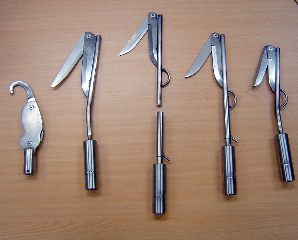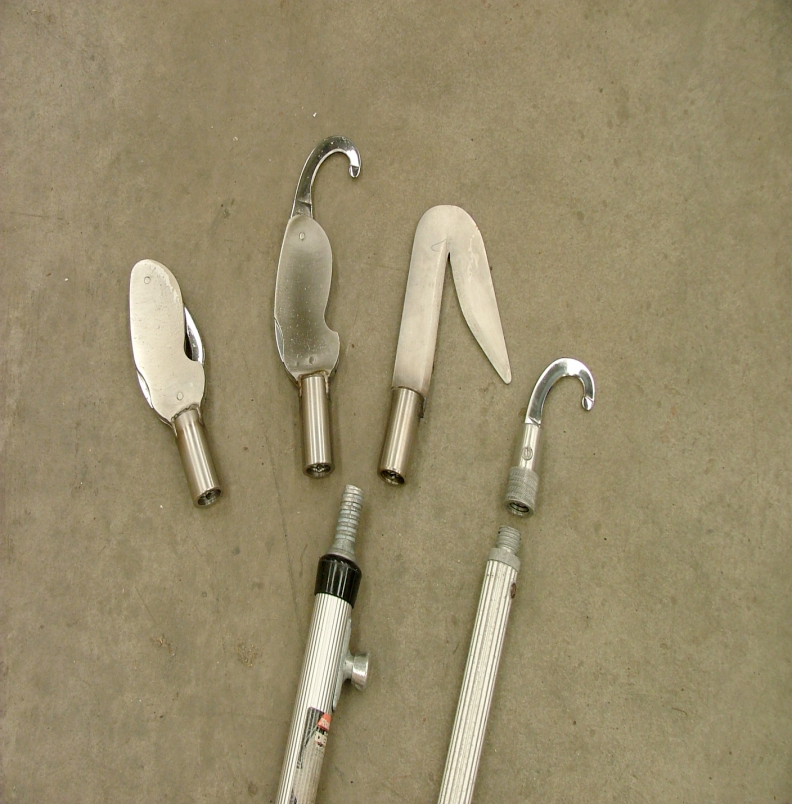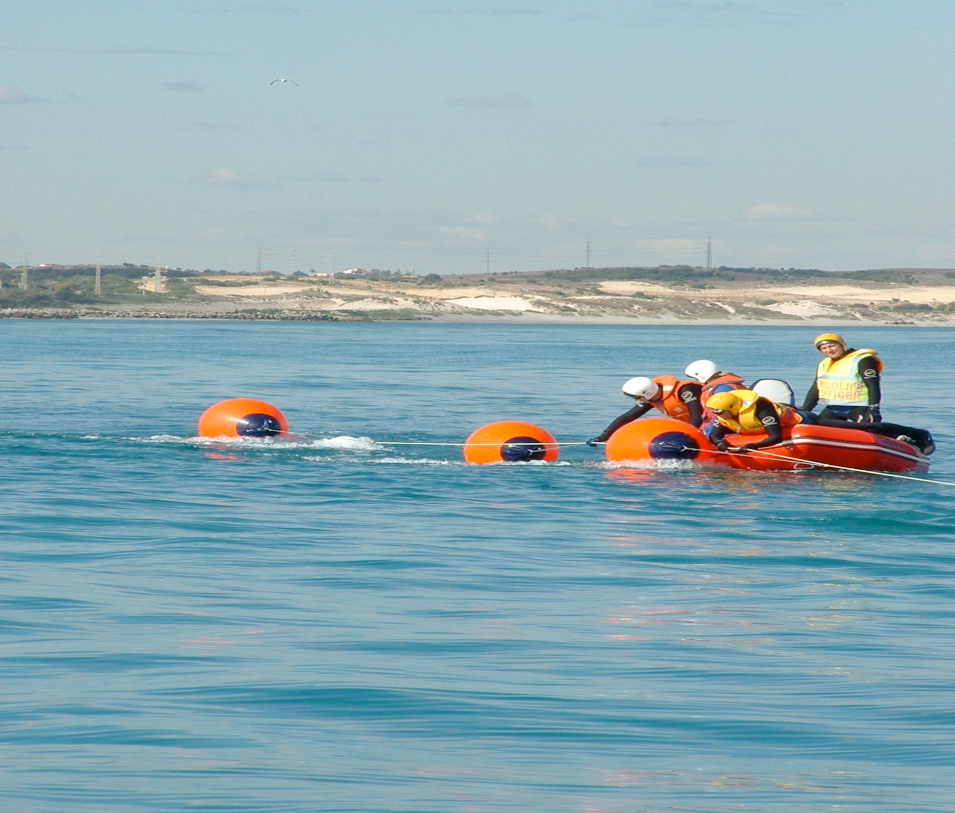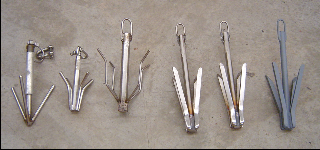GUIDELINES FOR THE STRATEGY AND DEPLOYMENT OF
LARGE WHALE ENTANGLEMENT RESPONSE EQUIPMENT
for
DEPARTMENT of ENVIRONMENT
and
CONSERVATION
LARGE WHALE DISENTANGLEMENT STANDARD OPERATING
PROCEDURE
(IMPLEMENTATION OF THIS DOCUMENT REQUIRES A TRAINING PRE-REQUISITE)
DOUG COUGHRAN
SENIOR WILDLIFE OFFICER
NATURE PROTECTION BRANCH
DEPARTMENT OF ENVIRONMENT & CONSERVATION
WESTERN AUSTRALIA
Version 4
Purpose of Procedure
Provide skills and knowledge required to disentangle large whales in a safe,
disciplined and structured manner.
Personnel will operate in accordance with occupational safety and health
guidelines and organizational procedures.
Incident Control System (ICS)
The Department of Environment and Conservation (DEC) manages responses to
entanglements using the Incident Control System (ICS) of the Australian Intra
Service Incident Management System (AI MS). The ICS is a structure that ensures
all vital management (actions) and information (procedures) are undertaken
properly.
ICS is the combination of personnel, procedures, facilities, equipment and
communications operating within an organisational structure with responsibility for
managing resources to effectively accomplish incident objectives. It is a modular
structure that can be expanded or contracted depending on the size or stage of
the incident. When ICS is expanded is divided into four functions:
Incident Control (IC): An IC will be designated by the responsible agency to have
overall management of the incident. The IC prepares objectives upon which
subsequent planning will be based. It is the IC responsibility to approve an
Incident Action Plan and approve all requests for personnel or resources.
Operations: Established to deploy resources at the incident and is responsible for
the control of operations in accordance with the
Incident Action Plan. Managed
by the Operations Officer.
Planning : Supports the incident by collection and analysis of incident information,
outcome prediction, location of personnel & resources, strategies to manage the
incident and preparation of the
Incident Action Plan.
Logistics: Support the incident, with the responsibility for services (first aid, food,
fuel), materials, equipment and communications. Managed by the Logistics
Officer.
Key Principles of ICS
Management by Objectives
A process of consultative management where the management team
determines the outcomes of the incident. These outcomes are communicated to
those involved so that they know and understand the direction to be taken.
Span of Control
Relates to the number of groups or individuals which one person can successfully
supervise / manage at an incident. The maximum is 5. Direct responsibility for
more than 5 impacts on the ability to ensure safety and effective operation
delivery.
Equipment
Experience and training with entanglements, including interstate has resulted in
the identification of the following equipment. The list is a basic set of equipment;
the minimum required to perform the task. Techniques, strategies and types of
entanglements do vary, resulting in the need for additional equipment and
resources. Incidents may require a revision, addition and ongoing development
of equipment and modified techniques.
Basic Kit;-
3 x grapple with trace
1 x 10 metre grapple throwing line
1 x 10 metre main line
2 x 30 metre main line
2 x 30 metre silver rope
2 x 50 metre silver rope
8 x personal safety knives
8 x end of line floats
5 x large buoys (A4/A5/A6 type floats)
2 x extendable pole sections with Hoffman 911 blade attachment
4 x additional cutting tools, with extendable pole attachment
Cutting heads with pole attachment capability of cutting light/medium and
heavy line
6 x Carabiner clips (none-locking) and pole adaptors.
1 x 20 cu/ft pony bottle with regulator (optional)
1 x Mask/snorkel for over bow assessment.
1 x sub-surface viewer
1 x Dive slate and pencils
1 x buoy (float) inflation device
1 x Satellite/VHF harness and buoy
1 x Helmet Camera and 1 Pole Camera
Radio communications
Staff operating in the point boat will require;
Full wetsuit






Buoyancy vest
Gloves, diving boots and helmet
Personal Safety knife located in a universal location, in easy access
Vessels
A minimum of 2 vessels are required to facilitate a safe rescue operation.


Consideration should be given to the combination of 2 inflatable vessels in
addition to the main large support vessel.
Inflatable (approximately 12-14ft)
This vessel is the main operational platform to assess, perform the entanglement
removal and monitoring. It is essential that only disentanglement staff essential
equipment be carried.
This vessel is maintained by a helmsman, a specialist crew member at the bow
and a third specialist crew person to ensure trailing lines are clear of the engine
leg and to assist the crew at the bow. A second inflatable with a minimum of two
crew perform support duties and assist with a safety line or apply tension to the
main working line when the main operational inflatable is on the main working
line with motor up. It is essential to maintain tension on either a safety line or the
main work line when the main operational inflatable is working in close proximity
to the entangled whale.
It is essential that the deck of the inflatable be kept clear and free of lose objects
and any other materials or equipment which may potentially interfere with the
safe deployment of running lines during the operation. Additional key equipment
can be carried in the support inflatable and the main support vessel along with
additional personnel.
Fatigue and exposure to the cold is a potential safety issue, team members
working in the inflatable are to monitor each other team member to ensure their
health and well-being is not compromised. This may vary due to weather
conditions and temperature.
Support Vessel (20-30 ft)
A large support vessel will be needed to carry necessary personnel, equipment
and maintain a multiple communications support system. It must comply with
Navigable Waters Survey Regulations. A support vessel is mandatory when
dealing with large whales. This vessel should also carry human first aid and
resuscitation equipment including qualified staff to deal with possible
eventualities.
Safety of Team Members
It should be stressed that it is critical to recognise that removal of entanglements
from whales is a very dangerous task that should not be undertaken without
appropriate training, equipment, Incident Management structure and resources.
The variables of the nature of the animals, lack of predictability, complexity of
entanglement, equipment, working environment, sea, tides & weather make for a
difficult combination.
Whales are large and are capable of inflicting injury or death, particularly if
harassed or distressed. All precautions must be taken to protect the public and
staff when responding to large whale entanglement incidents.
At no time should
anybody enter the water. Marine animals entangled in monofilament net pose an
extremely dangerous high probability of entangling an in water person assessing
or attempting to assist the animal
. The first priority is people safety fol owed by
animal welfare. Large
predators often frequent the location of a distressed whale.
GENERAL SAFEY
• Do not put the whales rescue above human safety at any time
• Only trained operators to participate in disentanglement activities.
• Any action needs to be thoroughly planned, with full briefing to all
participants. All participants need to be clear on aims, objectives, operational
procedure and roles.
• Focus on the job, but pay attention to the overall environment.
• Actions need not be pressured by weather, onlookers, or the perceived need
to act.
PERSONNEL EQUIPMENT
• Personal safety knives on each individual at all times
• Complete wetsuit, gloves, boots and PFD required at all times.
• Helmets are to be worn, particularly if working close to the whale or with poles.
POINT BOAT & SUPPORT VESSEL
• Never approach the whale directly from behind.
• Avoid the ‘danger zone’ – the range of movement of the tail flukes
• Easy – quick lift mechanism on the outboard is a pre-requisite for the point
boat.
• Ensure effective communication between vessels, the Incident Controller and
land based support vessels.
• Minimise the equipment (and personnel) in the point boat – use the support
vessel to carry additional equipment and personnel.
• Ensure each inflatable has a spare knife at the transom.
DURING DEPLOYMENT OF KEGGING PROCESS
• Be aware of location of your equipment and tools at all times.
• Be aware of the location of the whale, and that of other team members.
• Keep all gear attached to whale out of the inflatable & free from the engine.
• Never attach the inflatable to the whale.
• Stay clear of any load bearing line;
Do not loop any rope around hand, foot
or body.
Operational Strategy
‘Kegging’ is term to describe the process of attaching a series of trail lines to the
entanglement. These lines, along with a series of large floating buoys aim is to
slow the progress of the whale and accelerate fatigue and keep the whale at
the surface sufficiently to enable the disentanglement team to safely and
effectively remove the entanglement.
The strategy varies according to a number of variables, some of which are listed
below;
The animal
Size, species, temperament, behaviour, condition, company of other cohorts and
the presence of sharks are all factors requiring consideration by experienced and
qualified personnel in determining the strategy to be employed.
Nature of the Entanglement
Entanglement can occur by way of nets, ropes, fishing line, floating debris. The
amount of entangled debris trailing the animal and whether the animal is
tethered, stationery or free swimming will impact on the strategy to be utilized.
These include;
• Entangled in rope and mobile
• Entangled in rope and anchored to the seabed, only capable of swimming in
a circle.
• Entangled in net and mobile.
• Entangled in net and anchored to the seabed, only capable of swimming in a
circle.
• Entangled in net and rope, mobile.
• Entangled in net and rope, anchored to the seabed and only capable of
swimming in a circle.
• Entangled in net and/or rope and immobile.
Weather conditions, water depth, location and availability of resources are
factors.
The strategy to be employed will require the attachment of the rescue
equipment by the most appropriate means (as determined by the initial
assessment). This equipment is used to impose a condition of exhaustion to the
point where the animal can be safely approached by a disentanglement team
to achieve the release of the entangled gear.
Assessment
The assessment establishes the species, size and condition in addition to the type
of entanglement and any potential obstacles to the rescue operation.
The initial approach is often from behind, off centre and parallel to the animal (to
minimize disturbance and avoid startling the animal). A safe distance must be
maintained. The approach must be as slow and as quiet as possible so as not to
add to the confusion and anxiety of the animal.
Rescue
(Scenario for a Net and/or Rope Entanglement and mobile).
Equipment Preparation
Kegging (a process of attaching a working line with large floats to the
entanglement) remains the primary method to reduce the movement of an
entangled free-swimming whale. This strategy aims to slow (through fatigue) the
movement of the whale and keep it at the surface to a stage where removal of
the entanglement can be safely attempted.
The process involves deployment of pre-prepared equipment by trained
operators in a small inflatable, supported by participants in an additional
vessel(s).
Phase 1
Technique for very active fast moving whaler
A grapple hook or carabiner is connected to a 10 metre throwing line. This is then
connected to the snap hook on a small float. If a grapple is used, the line is
thrown to achieve attachment to the entanglement. If it is possible to make a
more controlled approach and attachment to the entanglement, then a
carabiner is deployed via a self-release pole and adaptor. All lines are spooled
such that they feed out of a round tub. An initial 30 metre main line with a small
float is attached to the end of the 10 metre throw line, once it has been
deployed, followed by a second 30 metre section of mainline with a small float
attached at the trailing end. If required, all lines have a snap shackle at one end
and an attachment ring at the other and are identifiable by pink flagging tape.
This technique has been developed as a most effective way of attaching a work
line when a whale is very active and travelling and diving at speed. It makes
working the main line possible under strain and the attachment of floats
achievable at pre-set locations along the main line.
The end of line float must be within ready access for attachment to the end of
the main line as it is deployed. The float clearly identifies the lines end.
The large buoys (floats) are inflated on the support vessel with the use of the
dedicated inflation device (this can be a standard SCUBA tank or
compressor/pump), ready for deployment.
A slow and quiet left or right of rear approach is made by the inflatable to attach
a mainline by using the grapple hook/carabiner by picking up a trailing rope.
Once the mainline has been attached, a slow and controlled deployment (feed
out) of the line is executed to avoid fouling.
In the event of an uncontrol ed situation developing or snagging, fouling or
similar, the mainline is to be cut immediately.
In the event of a person overboard, al operations are to be suspended and
attention diverted immediately to retrieve the person overboard.
In the event of an accident involving personal injury to any of the crew, al
operations are to be suspended and immediate management of the incident wil
take priority. The Skipper of the support vessel wil manage the incident.
As the mainline is deployed it may be possible to break the length of the line at
any of the connecting points if required. In the case of a highly mobile animal,
the full 70 metres of line should be deployed, however in the case of an
exhausted or placid animal, 40 metres of line may be sufficient.
Phase 2
Load is applied to the line by deploying the large buoys (floats), starting at the
furthermost pre-set attachment ring from the animal on the mainline. Working
forward towards the animal the remaining large buoys (floats) are attached at 5
metre pre-set attachment points.
Phase 3
As the animal tires, the large buoys (floats) are progressively leap frogged forward
along the mainline. The buoys help keep the animal at the surface so the team
can work on the entanglement. This load has the potential to free the whale of
the entanglement under some circumstances, maximising the safe distance
between the whale and team members.
Technique for less active slow moving or stationary whale
If a whale is already fatigued, slow moving or stationary (whether anchored or
not) the second option and most often used technique is to use a 30 or 50 metres
coil of “silver rope” with a grapple or carabiner attachment at one end and a
end of line float at the other. This is one continuous main working line that
achieves two main functions. The first is a work line for the disentanglement crew
to work along the line to attach floats by way of figure eight knots and work
along the line to carryout assessments with the motor up most achievable if there
is forward motion. Secondly, it doubles up as a safety line the second inflatable
sits at the end of and maintains tension on the line, especially if the whale stops
moving. This allows the disentanglement crew to work with total control whilst their
motor is lifted out of the water, allowing them to work quietly and with less
chance of engine snagging at close proximity. This technique al ows greater
control at close proximity when using pole cameras, assessment and cutting tools.
The buoyancy of “silver rope” gives the advantage of being able to see were the
surplus and slack rope is all of the time. Some grades of rope are negative
buoyant and therefore difficult to see most of the time.
Safety Line
A safety line may be required managed by the point boat helm, run back to the
support vessel or a third support boat as a means of maintaining control of the
point boat to ensure a safe zone from the whale’s tail, especially if the whale has
stopped swimming. It is also possible to manoeuvre the vessels and change the
angles to the whale by the second inflatable standing off at distance, thus
maintaining control of the placement of the disentanglement team and
eliminating the need to engage the motor on the point boat.
Release – entanglement removal
Once the animal is sufficiently worn down through exhaustion the inflatable
moves up to the animal to cut free the entanglement. The technique of walking
up the line (motor tilted out of the water) allows a quiet and controlled approach
supported by a safety line to a support vessel. This phase of the operation may
involve a prolonged effort of cutting but must not be rushed. All phases of the
operation must remain slow and steady.
Divers wil not be permitted to enter the water.
Monitoring.
Upon the successful completion of the rescue the condition of the animal should
be suitably monitored for as long as is necessary.
Debrief
All operations are followed by a wind down and debriefing to improve on future
operations.
It is an opportunity to discuss the level of preparedness, the equipment, the
process and identify any changes to procedure or equipment that could be
made to improve.







